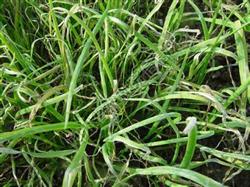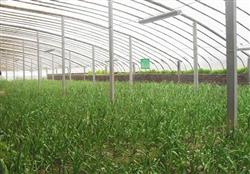Technical knowledge of fertilization in planting and cultivating garlic

According to the growth and development of garlic and the characteristics of fertilizer demand and absorption, garlic fertilization should adhere to the fertilization principle of "giving priority to organic fertilizer, supplemented by chemical fertilizer, giving priority to base fertilizer, supplemented by topdressing, applying coarse and fine fertilizer and skillfully applying chemical fertilizer". In order to meet the needs of nutrient elements in the process of garlic growth and development to the maximum extent. Fertilization of garlic is generally divided into base fertilizer and topdressing fertilizer. Base fertilizer. The base fertilizer should be based on organic fertilizer. Organic fertilizer usually refers to ring manure, chicken manure, duck manure, barnyard manure, compost, cake fertilizer and so on. Whether the amount of base fertilizer is sufficient or not is directly related to the commodity of garlic and the overwintering performance of the plant, so sufficient base fertilizer should be applied in production. The application amount of base fertilizer should be determined according to many factors, such as the target yield of garlic and the fertilizer requirement of yield per unit area. The application of pigsty fertilizer 2500-3000 kg or barnyard manure 4500-5000 kg is required. Conditional application of cottonseed cake and other cake fertilizer 50-100 kg. It can also be used as base fertilizer for green manure crops such as alfalfa and fresh grass retting. The chemical fertilizers used with organic fertilizer as base fertilizer usually include calcium superphosphate, nitrogen-phosphorus compound fertilizer, nitrogen-potassium compound fertilizer or ternary compound fertilizer and so on. About 75 kg of standard nitrogen fertilizer is applied for every 667 square meters. Nitrogen fertilizer should be applied with 2 base fertilizer and 1 top fertilizer. Most of the phosphorus and potassium fertilizers are used as base fertilizers. Phosphate fertilizer uses about 30 kilograms of calcium superphosphate. When phosphate fertilizer is used as base fertilizer, both calcium superphosphate and calcium magnesium phosphate fertilizer should be mixed with organic fertilizer, and shallow ploughing should be turned into plough layer. The amount of potash fertilizer applied is generally about 30 kilograms of potassium sulfate per 667 square meters. Generally speaking, the application method of base fertilizer is to apply half of the organic fertilizer in front of the cultivated land, spread it evenly on the soil surface, combine the cultivated land, turn the fertilizer into the ground; when sowing, concentrate on ditch application, and mix fertilizer and soil, and then sow. If ammonium bicarbonate or organic fertilizer is used as base fertilizer, it should be buried in trenches or poured with water, and the fertilizer should be evenly mixed with soil preparation after application. The application of phosphate fertilizer should be shallow, concentrated or layered. One part can be applied in front of the cultivated land, the other part can be applied when planting garlic after ploughing, or shallowly applied to the ground 6-10 cm after soil preparation, so as to facilitate the absorption and utilization of seedlings, cultivate strong seedlings and improve the utilization rate of phosphate fertilizer in the current season. Potash fertilizer can be applied along with the cultivated land and turned into the ground when cultivated land is cultivated. ② topdressing. In each growth period from seedling stage to bulb harvest, fertilization was carried out by stages according to its growth and development and the characteristics of fertilizer requirement and absorption, that is, topdressing of garlic was mainly nitrogen fertilizer. When needed, nitrogen, phosphorus, potassium and various elements should be applied together, which is beneficial to the normal growth and development of garlic, promote the absorption and utilization of nutrients and improve the quality. Nitrogen fertilizer has a significant yield-increasing effect on garlic. When topdressing nitrogen fertilizer, attention should be paid to the possible adverse effects. According to the experiment, the effect of topdressing nitrogen fertilizer is closely related to the size of garlic cloves. The smaller the garlic cloves, the greater the yield increase with nitrogen application. Therefore, when using small cloves of garlic to grow garlic, the amount of nitrogen fertilizer should be increased appropriately. Topdressing phosphate fertilizer and potassium fertilizer can improve the balanced absorption and utilization of nitrogen fertilizer, promote the growth and development of garlic, and increase the yield of garlic bolting and garlic head. In the later stage of garlic, we should apply not only nitrogen fertilizer, but also phosphorus and potassium fertilizer, nitrogen, phosphorus and potassium fertilizer according to 2:1:1, or compound fertilizer. This is beneficial to prevent the premature senescence of leaves in the later stage of garlic promote the transport of nutrients from leaves to the bulb and significantly increase the yield of garlic bolting and garlic head. The period of topdressing can be divided into topdressing before overwintering, returning to green stage, topdressing at the extension of garlic bolts and topdressing during the growing period of garlic. Topdressing before overwintering: topdressing before overwintering is mainly to promote the normal germination and emergence of garlic and cultivate strong seedlings. Before winter, the appearance of strong seedlings is: there are 5 leaves, plant height is about 25 cm, fresh weight per plant is about 10g, root system is uniform, there are about 30. The seedlings of autumn sowing garlic can be produced 7-9 days after sowing. In order to improve the safe overwintering performance of garlic, topdressing and promoting seedling fertilizer is applied. Promoting seedling fertilizer generally accounts for about 25% of the total topdressing amount. For varieties prone to outer cross growth, little or no fertilizer should be applied to promote seedling growth. Garlic into the overwintering period, can be applied overwintering fertilizer that is wax fertilizer. Wax fertilizer is often applied with compost, soil manure or horse manure to thicken the overwintering protective layer of roots, improve the overwintering performance of seedlings and ensure safe overwintering. At the same time, it is also conducive to the next year early return to green, rapid growth. Topdressing during the return to green period: when the daily average temperature in spring reaches 7 degrees Celsius, the garlic seedlings begin to turn green and grow. At this time, the mulch should be removed in time, sun-cured seedlings for 2-3 days, and before and after the Spring Equinox grows, return to green fertilizer once. Generally, 1000-1500 kg of organic fertilizer or 10-15 kg of standard nitrogen fertilizer is applied every 667m2. For those who have applied seedling promoting fertilizer and overwintering fertilizer, the returning green fertilizer may not be applied during the returning period, or the returning green fertilizer may be postponed to be combined with bolting fertilizer. Long-term topdressing of garlic bolting: the long-term topdressing of garlic bolting refers to the topdressing from the beginning of differentiation of garlic cloves to before bolting. This period is the period of the growth of garlic bolts and garlic cloves. In Shandong Province, it is generally at the end of March and the beginning of April, that is, before the Qingming Festival, garlic enters the differentiation period of garlic bolts and cloves, and May 20, that is, around Lesser Fullness of Grain, enters the bolting stage. In this period, the elongation of garlic bolts overlapped with the early growth stage of garlic, and it was in a period of exuberant growth. At this time, all the leaves have grown, the growth of the aboveground part of the plant has reached the maximum, the yield of garlic in the underground part has formed nearly 50%, the root system has actively expanded horizontally, and the growth and absorption have gradually reached the peak. so topdressing should account for about 40% of the total topdressing. It is necessary to increase the application of compound fertilizer and potash fertilizer to promote bolting and expansion of garlic. Topdressing of garlic during the growing period: before garlic stalk harvest, the growth of garlic is mainly to increase the volume, after garlic stem harvest, the growth of garlic is mainly weight gain, the average daily weight gain is about 1g, the daily increase diameter is about 0.06 cm. In the growing period of garlic, available nitrogen fertilizer should be the main fertilizer, combined with phosphorus and potassium fertilizer. The amount of topdressing should account for 25% of the total topdressing. 30%. The method of topdressing garlic is generally applied in strips, with water or buried. When applying soil and miscellaneous fertilizer, it can be trenched and scattered into strips; when applying chemical fertilizer, it is generally used to spread ditch or hole application, cover soil after application, water, or sprinkle with water, or take advantage of rain. Attention should be paid to strengthening weeding in ploughing and keeping soil loose and soil moisture so as to speed up the absorption and utilization of nutrients by roots. ③ foliar fertilization. Foliar fertilization can make nutrients enter into the plant from the leaves and directly participate in the metabolic process of the plant and the synthesis of organic matter. its effect is faster than that of soil fertilization, so it is an economical and reasonable fertilization technology. Studies have shown that after the application of allicin, the enzyme activity in the roots, stems and leaves of garlic seedlings can be increased by 15%, 31%, and increased by 12%, 14%. Foliar spraying garlicin, should be diluted with water, every 667 square meters with the original solution of 125-150g, add water 50L. During the spraying period, it can be sprayed once in the garlic growing period (March), the garlic stalk differentiation period, the bulb growth period and 2-3 days after garlic stalk harvest. When spraying, the leaves should be sprayed on both sides, preferably after 4 p.m., and the weather should be clear when spraying. If it rains within 24 hours after spraying, it should be re-sprayed. Garlic should be combined with watering and fertilization, timely ploughing, planing (border stalks) weeding. After the emergence of the seedlings, the second and third leaf stage of shallow hoe weeding, loosen the soil to preserve soil moisture. 4-5 leaves when the deep hoe about 15 cm, the next year after the shallow hoe, every 4 lines of garlic planing to repair border stalks, in order to fertilize and irrigate.
- Prev

Control of Botrytis cinerea of leek in greenhouse
Botrytis cinerea is easy to occur when the humidity is high in the leek greenhouse. After the onset of the disease, the leaves gradually produced grayish brown to white spots from the tip down, both positive and negative, oval or fusiform disease spots were enlarged, and fused into large dead spots. The air humidity is more than 85%, the temperature is 15 ℃ ~ 20 ℃, warm and humid strip.
- Next

The technique of planting garlic after planting Cucumber in Maize
Garlic is a necessary condiment in daily life, which is indispensable for cooking and cooking. In recent years, many pharmacological effects of garlic have been discovered, and it has been found that garlic can prevent and treat a variety of diseases. American scientists have listed garlic as a basic health food. At present, garlic has become a worldwide vegetable, especially in.
Related
- Where is it suitable to grow horseradish in China? it is expected to see the middle altitude horseradish in Alishan.
- How to prevent tomato virus disease reasonably? (Control methods included)
- Many people like to plant towel gourd on the balcony. What are the main points of this method and management?
- What crops can chili peppers be mixed with?
- Fertilization techniques and matters needing attention in Tomato
- What are the grafting techniques for peach seedlings in spring?
- Harm and control methods of root swelling disease of Chinese cabbage
- What are the pests of sweet potatoes? How to prevent and cure it?
- Symptoms, causes and Control methods of navel Rot in Tomato
- The cause of "Cucumber rotten bibcock" in Farmers' planting Cucumber and its Control Plan

